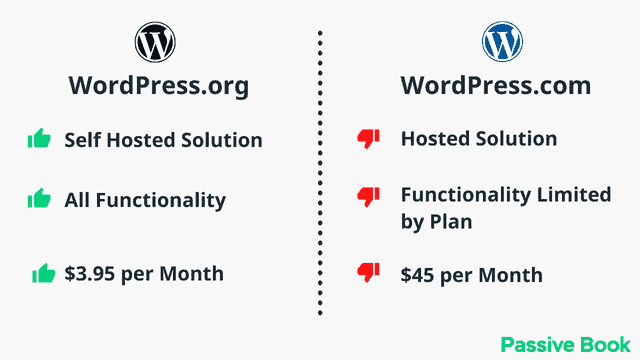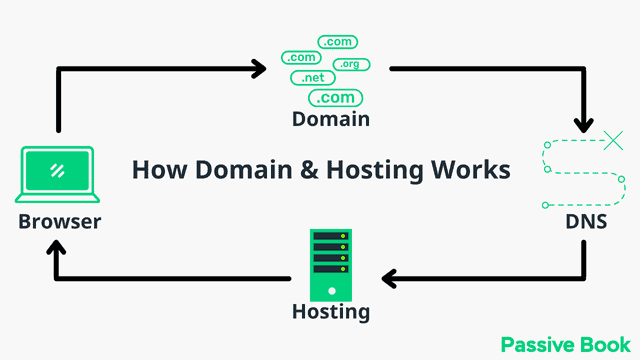Are you new to blogging and wondering what is the best blogging sites to start a new blog?
In this post, we’ll go over the [auto-list-number display=”total”] best blogging platforms to build a blog for free. We’ll provide an overview of each blogging platform so you can choose the one that is best for you.
Read on to find out which is the best platform for your needs.

What is a Blogging Platform?
A blogging platform (or blogging site) is a software or service that helps you create and manage your blog. It includes everything from the design of your blog to the publishing of your posts.
Best blog sites in 2026
Here are the best blogging sites to start your own blog today:
[auto-list-number] WordPress.org (Self-Hosted)
WordPress is a content management system (CMS) that allows you to create a website or blog from scratch without learning how to code. WordPress is a free and open-source software released under the GPL. This is one of the best free blogging sites in 2026. This is a self-hosted platform which means you need to get your own domain name and hosting.

There are many blogging platforms but the self-hosted wordpress.org powers 70% of blogs on the internet. 42% of all websites on the internet use WordPress making it one of the popular blogging platforms. It is used by millions of people around the world, including many large organizations, such as The Guardian, Forbes, and The New York Times.
WordPress is popular because it is easy to use and has a large community of developers who create plugins and themes that allow you to customize your site. It also has a large amount of documentation and support forums.
This is the best blogging platform and it is the one we recommend. To start a blog with self-hosted Wordpress, check out our guide on how to start a blog.
Pros
- Customizable: You can install themes to customize the look of your blog and make it look exactly the way you want using a drag and drop editor.
- Flexible: You can add advanced features and functionality to your WordPress blog by installing Wordpress plugins. Using plugins you can easily convert your WordPress blog into a forum, ecommerce store, membership website or any other type of website you can imagine. You can do all this for free.
- Monetizable: You can monetize and make money from your self-hosted WordPress blog, however you want. You can earn a commission through affiliate links or use Google Adsense or sell digital products.
- Complete Ownership: You own your content. Your blog cannot be deleted or shut down by someone else.
- Use a custom domain (example.com) without paying extra.
- Large community: There is a large community of developers and users who can help you with support and advice.
- Free and open source: WordPress is free software released under the GPL.
Cons
- Requires hosting and a domain: To use WordPress, you will need to get your own hosting and a domain. If you use Bluehost, it will cost you $2.95 per month or $36 a year.
- Can be slow: If you don’t optimize your WordPress site or install too many plugins, it can slow down your website and make it sluggish.
- Can be hacked: Any website can be hacked, but WordPress sites are a target for hackers because they are so popular. It is important to keep your WordPress site secure using a security plugin.
Plan & Pricing
WordPress is free and open-source software released under the GPL. It is the best free blogging platform available. But you will need to get your own hosting and a domain which will cost you around $2.95 per month if you use Bluehost. If you go with Bluehost you will also get a free domain and a free SSL certificate. This is the cheapest and the best way to build your blog. You can find many free hosting providers but they are not reliable and can infect your blog to spread malware.
Examples
- PassiveBook.com (Yes our blog is built on self-hosted WordPress.org)
- Pinch of Yum
- NomadicMatt.com
[auto-list-number] WordPress.com (Hosted)
WordPress.com is a blogging platform that is owned by Automattic. It is similar to WordPress.org in that it allows you to create a blog or website using WordPress. However, with WordPress.com, you do not need to get your own hosting or domain as it is all included in the price.

The main difference between WordPress.org and WordPress.com is who owns the platform and how it is hosted.

- WordPress.org: You own the platform but you need to get your own hosting and domain. You can install plugins and monetize and make money from your blog without paying extra.
- WordPress.com: WordPress owns the platform and they provide the hosting and domain for you. Although free to start, you need to upgrade to their expensive paid plan to make money, install plugins & add a custom domain.
The major drawback of WordPress.com is that you cannot install plugins nor can you monetize and make money from your blog unless you get their paid plan.
Pros
- Free Sub-Domain: You get a free sub-domain when you sign up for WordPress.com.
- Free Hosting: You don’t need to worry about finding a host or paying for hosting as it is all included in the price.
- SSL Certificate: WordPress.com includes an SSL Certificate which is important for security and ranking in Google.
- Jetpack: Jetpack is a plugin that comes with WordPress.com that gives you features such as site stats, security, backup, and more.
- Easy to use: WordPress.com is designed to be easy to set up and use, even for beginners.
- Zero Maintenance: You don’t have to take backups or handle updates. WordPress takes care of it for you.
Cons
Some of the cons of using WordPress.com include:
- Cannot Monetize: If you are on the free version you cannot monetize and make money by showing ads or having affiliate links in your WordPress.com website unless you upgrade to their paid plan.
- Limited control and flexibility: You cannot install plugins in WordPress.com in their free plan.
- Upselling: There is upselling on WordPress.com, which means they try to get you to buy upgrades and add-ons.
- Ads: WordPress.com shows ads on your blog unless you upgrade to the paid plan.
- No Ownership: You don’t own your content on WordPress.com. The platform can decide to shut down your blog without notice.
Plan & Pricing
WordPress.com has 2 plans:
- Free: The free plan is just that, free. You can create a blog or website on WordPress.com for free. However, there are some limitations such as not being able to install WordPress themes or plugins and you will have ads on your site. You also cannot monetize your blog and make money online.
- Pro: The pro plan costs $15 per month and removes the ads from your site. You can also use a custom domain and install plugins and themes with this plan.
Examples
- lyndonandgardening.wordpress.com
- beautycandy.wordpress.com
- quantitativetravel.wordpress.com
[auto-list-number] Medium.com
Medium is different from other blogging platforms because the platform is optimized for discovery and not search. This means users of the platform will discover content published on medium through recommendations from medium. So this will be a different blogging experience.

It is very similar to how users discover content on a social media platform like Instagram, Facebook, or Twitter.
It is not easy to monetize your content published on Medium. Yet many brands republish and syndicate their posts on medium to reach an additional built-in audience. Their original post is published on a platform like WordPress but they get syndicated to Medium. To avoid duplicate content issues, Medium adds a rel=canonical tag so that search engines like Google ranks the pages on your WordPress blog instead of the posts on Medium.
The major drawback of using Medium is that you will be competing with so many other writers on the platform to have your content discovered. Medium might have a huge readership, but it doesn’t mean you will get any new readers because there is a huge competition for attention.
Pros
- Audience: Medium has an audience of its own. If your content is good, it can quickly gain traction and get discovered on the platform.
- Syndication: If you have a blog on self-hosted WordPress, you can republish it on Medium by adding rel=”canonical” tag. You will be able to tap into Medium’s traffic without running into duplicate content issues.
- Monetization: You can earn a small amount of money if someone reads your content. However, you need to be in a country that has Stripe to be able to get paid.
- Easy To Start: You can start writing on Medium without having to worry about hosting, domain names, or any of that technical stuff.
- Focus on Writing: You don’t have to worry about driving traffic, SEO, and link building because Medium has its own audience who will read and discover your content.
- Potential To Make Money: If your content is good, you can make a small amount of money from each person who reads it.
Cons
- Content Behind Pay Wall: Your content will be put behind a pay wall, which means that non Medium users need to pay to read it. This will limit the reach of your blog posts.
- No Control Over Audience: You have no control over who reads your content as it is shown to people based on Medium’s algorithm.
- Competition: You will be competing with thousands of other brands and authors on the platform to get a share of readers.
- Limited Customization: You cannot customize your Medium blog or website as there are no plugins or themes like WordPress.
- Not Fully Yours: Your content is not fully your own as it is hosted on Medium’s platform. This means that if Medium decides to shut down or change its policy, your content could be taken down with it.
- Not Building Your Brand: You are building Medium’s platform, not yours. The links and traffic you drive to your content will help people discover Medium and other authors who publish on the platform.
- Cannot Monetize: You cannot show your own ads or sell digital products through your medium blog. You will be greatly limiting your earning potential.
Plan & Pricing
Free for you to write but readers have to pay $10 per month to read on Medium.
Examples
- seanjkernan.medium.com
- aninjusticemag.com
- uxplanet.org
[auto-list-number] Blogger.com
Blogger is a free blog platform and blog-publishing service that allows multi-user blogs with time-stamped entries. It is owned by Google. Also known as Blogspot, it is one of the oldest blogging platforms still in existence.

However, Blogger has been criticized for being outdated. It can also be hard to find support if you need help with your blog. It can be difficult or close to impossible to rank blogs built on Blogger on Google. You can only use the free themes available making your blog look like everyone else.
But if you want to create a free website or personal blog which is not focused on making money or getting traffic then Blogger is one of the best free platforms to start a blog. You can get your blog up and running in minutes.
Pros
- Free: Blogger is free to use, which makes it a great option if you’re on a budget.
- Custom Domain: You can use a custom domain name with your Blogger blog (e.g. www.example.com). However, you will have to pay for the domain name.
- Templates: You can choose from a selection of templates to customize the look of your blog.
- Multiple Authors: You can have multiple authors contributing to your blogger blog.
- Easy to Use: There is nothing technical to do or set up in your Blogger blog. You can use your Google account to sign up for Blogger and start blogging.
Cons
- Not SEO Friendly: Ironically the platform is not optimized for search engines even though it is owned by Google. You will never see a Blogger blog rank top for any major search queries.
- Outdated: Blogger is considered an outdated platform. It doesn’t have some of the features that other blogging platforms offer.
- Not User-Friendly: Blogger can be hard to use, especially if you’re not familiar with HTML code.
- Limited Support: It can be hard to find support if you need help with your blog.
- Risk of Deletion: You don’t own your content. Your blog can get deleted overnight if it triggers some spam filter and you will have no way to recover your blog.

Plan & Pricing
Blogger is free to use. You can purchase a custom domain name for your blog for around $12 per year.
Examples
- halfanhour.blogspot.com
- jumiaafrica.blogspot.com
[auto-list-number] Tumblr.com
Tumblr is a microblogging and social networking platform that allows users to post text, images, videos, and audio content. It was founded in 2007 and acquired by Automattic in 2019. Tumblr has over 450 million blogs on its platform.

While Tumblr is a great platform for microblogging, it is not such a great platform for long-form content. Tumblr has been criticized for changing the rules that banned blogs that served adult content. Content censorship made Tumblr lose 30% of its traffic.
Pros
- Add Custom Domain: You can add a custom domain name to your Tumblr blog.
- Password Protection: You can password-protect your Tumblr blog to make it private.
- Built-In Social Networking: Tumblr has its own built-in social networking features, which allow you to follow other users and reblog their content.
- Free: Tumblr is free to use, which makes it a great option if you’re on a budget.
- Themes: Tumblr offers a selection of themes that you can use to customize the look of your blog.
- User Friendly: It is really easy to get started and there is nothing technical for you to learn.
Cons
- Not SEO Friendly: Tumblr is not optimized for search engines, which means it can be hard for people to find your blog.
- Platform Branding: There is a lot of branding for Tumblr on your blog.
- Content Censorship: Tumblr has been criticized for censoring content.
- No Ownership: You don’t own the content. Your Tumblr blog can get deleted overnight.
- Not for Long-Form Content: Tumblr is great for microblogging but not so great for longer-form content.
- Limited Customization: You can only customize the look of your blog so much.
Plan & Pricing: Tumblr is free to use.
Examples
- huntersgrave.tumblr.com
- tiktoksthataregood-ish.tumblr.com
[auto-list-number] Wix.com
Wix is a website builder that allows users to create a website without any coding knowledge. It was founded in 2006 and now has over 160 million users in 190 countries.

While Wix is a great platform for creating a website, it can be too expensive and not as flexible as other website builders.
Pros
- Drag & Drop Editor: Wix has a drag & drop editor that makes it easy to create a website, even if you don’t have any coding knowledge.
- Templates: Wix offers a selection of templates that you can use to create your website.
- Apps: Wix has a selection of apps that you can add to your website to extend its functionality.
- Easy to Use: Wix is easy to use, even if you don’t have any coding knowledge.
- SEO: Wix is optimized for search engines, which means it’s easy for people to find your website. However, the SEO aspects are a little bit outdated.
- Site Security & Speed: Wix will take care of your site’s security and speed. You don’t have to worry about managing the technical aspects of your blog.
- Support: If you ever run into any problem, you just need to contact their support.
Cons
- Locked To The Platform: Once you create your website on Wix, you’re locked into the platform. It can be hard to move your website to another platform like WordPress. You have to just keep paying expensive monthly fees to use the platform.
- Ads: Wix’s free plan shows Wix ads on your blog that makes your blog looks spammy.
- Expensive: You need to upgrade to their paid plan for basic features like adding a custom domain name. The paid plans of Wix are more expensive than other blog platforms.
- Not as Flexible: Wix is not as flexible as other blog platforms. Most of the Apps offered by Wix are iFrames that work okay. But it has nowhere near the power of WordPress plugins.
Plan & Pricing
Free to start. To connect a domain name you need to get the paid plans of Wix which starts at $4 per month. Additional features cost a lot more.
Examples
- oliviaandlaura.com
- seasonsincolour.com
[auto-list-number] Ghost.org
Ghost is an open-source blogging platform that was founded in 2013. It is used by over 1 million websites. It is a fast and lightweight content management system that will ensure your blog loads really fast.

It has built-in membership and newsletter capabilities so that you don’t have to rely on another platform to manage your newsletters.
Ghost is free to use if you self-host it. However, the hosting they provide as a service is extremely costly. Self-hosting Ghost is not as easy as self-hosting WordPress. It is a little technical to get started.
Pros
- Newsletter: Ghost has built-in newsletter features that are easy to use. You won’t need a third-party email service provider to manage your email newsletters.
- Membership Management: You can easily create a membership area on your blog and give access to only paying members.
- CDN: Ghost uses a CDN to deliver your content fast.
- Open Source: Ghost is an open-source platform, which means that it is constantly being improved by its community of users.
- Flexible: Ghost is a very flexible platform, which means that you can add a wide range of features to your blog.
- Lightweight & Fast: Ghost is a lightweight platform that loads really fast.
- Built-in Newsletter & Membership Featured: Ghost has a built-in newsletter and membership features that eliminate the need for third-party plugins.
Cons
- Complex to Self-Host: Ghost is a little more technical to self-host than WordPress.
- Limited Features: Ghost doesn’t have as many features as WordPress plugins.
Plan & Pricing
Ghost is free to self-host. However, you will need to pay for hosting which starts at $5 per month. If you get Ghost Pro, it starts at $9 per month for 500 members.
Examples
- thebrowser.com
- aliabdaal.com
[auto-list-number] Postach.io
Postach is a blogging platform that allows you to create a blog using Evernote. It was founded in 2012 and now has over 200,000 users. It is a great platform for bloggers who use Evernote, but it is too simple and does not have as many features as other blogging platforms.

With Postach, users can connect their Evernote account to the service and create notes with a specific tag, which are then automatically converted into blog posts on their Postach.io blog. Users can also customize the design of their blog and add features such as Google Analytics tracking, custom domain names, and social media integration.
Pros
- Evernote Integration: Postach allows you to create a blog using Evernote. This means that you can easily add notes, images, and files from Evernote to your blog posts.
- Themes: Postach offers a selection of themes that you can use to customize the look of your blog.
- Simple: Postach is a simple platform, which makes it easy to use.
Cons
- Custom Domain: To set up a custom domain, you need to upgrade to their paid plan.
- Limited Features: Postach doesn’t have as many features as self-hosted WordPress, which means you may need to use another platform if you want certain features for your blog.
Plan & Pricing
Postach is free to use. However, if you want to connect your own domain name, you will need to upgrade to their paid plan, which starts at $5 per month. You need to pay extra for additional features.
Examples
- alexnorth.me
- enjoyingmusic.co.uk
[auto-list-number] Weebly.com
Weebly is a website builder that allows you to create a website for free. You can choose from a selection of templates and then customize the look and feel of your website.

Weebly also includes a variety of features, such as a blog, an e-commerce store, and social media integrations.
Pros
- Drag & Drop Builder: Weebly offers a drag and drop builder that makes it easy to create a blog without any coding knowledge.
- Easy to Use: Weebly is easy to use, even if you don’t have any coding knowledge.
- Themes: Weebly offers a selection of themes that you can use to customize the look of your blog.
- Apps: Weebly has a selection of apps that you can use to add features to your blog.
- Good Site Speed: Weebly sites generally have good site speed.
- Easy to Migrate: If you want to move your blog from Weebly to another platform, it is relatively easy to do.
Cons
- Weebly Branding: If you don’t upgrade to a paid plan, your blog will have Weebly branding.
- Custom Domain: To use a custom domain, you need to upgrade to their paid plan.
- Limited Blogging Tools: Weebly doesn’t have as many blogging features as WordPress. The blogging features are built like a site builder.
- Pay for Support: To get support from Weebly, you need to upgrade to their paid plan.
Plan & Pricing
Weebly is free to use. However, if you want to connect your own domain name, you will need to upgrade to their paid plan, which starts at $5 per month.
Examples
- wetalkmoney.com.au
- butchwonders.com
[auto-list-number] LinkedIn.com
LinkedIn is a social media platform that allows you to connect with other professionals. LinkedIn also has a blogging feature called LinkedIn Pulse, which allows you to write articles and share them with your connections.

Pros
- Audience: LinkedIn has a large network of professionals that you can connect with.
- Blogging Feature: LinkedIn has a blogging feature that allows you to write articles and share them with your connections.
- Networking: When you blog on LinkedIn, you open up a lot of opportunities for networking and your career.
- Visibility: LinkedIn is a great platform to increase your visibility as a professional.
Cons
- Competition: Like Medium, there are a lot of other bloggers posting on LinkedIn. You will be competing with them to get attention and readers.
- No Lead Generation: You can build your email list or generate leads with LinkedIn. If LinkedIn sees that people who read your blog post leave their platform, then they will limit the reach of your blog posts to keep more visitors on the platform.
- Content Ownership: LinkedIn owns the content that you post on their platform. You can not move your blog posts off of LinkedIn if you decide to leave the platform.
Plan & Pricing: LinkedIn is free to use.
Examples
- https://www.linkedin.com/pulse/important-lesson-i-learnt-from-man-selling-water-nisha-kotecha
- https://www.linkedin.com/pulse/challenge-ambition-robert-ashton
[auto-list-number] Joomla.org
Joomla is a content management system that allows you to create a website or blog for free.
You can choose from a selection of templates and then customize the look and feel of your website.

Pros
- Templates: Joomla offers a selection of templates that you can use to customize the look of your blog.
- Extensions: Joomla has a wide selection of extensions that you can use to add features to your blog.
- Easy to Blog: Joomla makes it easy to blog with its content management system. It is really easy to create and edit blog posts.
- SEO: Joomla is optimized for search engines so it helps your website get found on Google.
- Open Source: Joomla is an open-source platform, which means that there is a large community of developers who contribute to the platform.
Cons
- Requires Technical Knowledge: Joomla is not as easy to use as WordPress.org. You will need some technical knowledge to be able to use Joomla effectively.
- No Automatic Updates: With Joomla, you will need to manually update the software when new versions are released.
- Limited Plugins: Although you can customize Joomla a fair bit, it is still limited in comparison to WordPress. If you have a specific need, you may have to hire a developer instead of using a plugin.
- Compatibility Issues: Because Joomla is open source, there can be compatibility issues with the extensions and templates.
Plan & Pricing: Joomla is free to use.
Examples
- gamersnexus.net
- gothamgazette.com
[auto-list-number] Jimdo.com
Jimdo is a website builder that allows you to create a website or blog for free. You can choose from a selection of templates and then customize the look and feel of your website.

Pros
- Free Plan: Jimdo offers a free plan that allows you to create a website or blog.
- SEO: Jimdo is optimized for search engines so it helps your website get found on Google.
- Support: Jimdo offers support in multiple languages.
- Templates: Jimdo offers a selection of templates that you can use to customize the look of your blog.
- Ecommerce: Jimdo includes a variety of features, such as an e-commerce store and social media integration.
Cons
- Page Count: You can only create a limited number of pages in their free plan.
- Paid Plan: You need to upgrade to their paid plan to access most features including SEO.
Plan & Pricing
The free plan allows you to create a website with up to 5 pages. The paid plans start at $9 per month.
Examples
- https://www.jimdo.com/examples/
[auto-list-number] Web.com
Web.com is a website builder and hosting platform that offers various plans for users to create a website.

The starter plan is free, but there are also monthly subscription plans that start at $4.99/month. With Web.com, you can create a website in minutes without any prior experience or design skills. The platform offers customizable templates and an easy-to-use drag-and-drop editor. You can also add features to your website such as contact forms, ecommerce, and social media integration.
Pros
- Easy to use website builder
- Ecommerce Tools
- No prior experience is necessary
- An array of tools for ecommerce
Cons
- Limited customization options
- The website builder is not strong as Wix or Weebly.
- Paid plans are expensive compared to the competition.
[auto-list-number] SquareSpace.com
Squarespace is a blogging platform that offers a simple, clean, and modern interface. It is known for its beautiful templates and designs. Squarespace also allows you to create a custom domain name for your blog.

Pros:
- Simple, clean, and modern interface
- Beautiful templates and designs
- Custom domain name support
- All-in-one platform: No need to install any extra plugins, widgets, or apps.
- Customer Support: 24/7 customer support via live chat, email, and phone.
Cons:
- No free plan: Squarespace does not offer a free plan. The cheapest plan starts at $12 per month.
- Editing: It can be difficult to edit and add content.
- No Advanced Marketing Tools: You can not find any tools for advanced marketing or SEO on Squarespace.
- No Third-Party Apps: There is no way to integrate any third-party apps or plugins.
Plans & Pricing: Plans start at $14 per month.
Examples
- https://newyorkyachtsales.com/
- https://topitoffgranite.com/
[auto-list-number] Penzu.com
Penzu is a free online journal and personal diary that you can use to record your thoughts, feelings, and memories.

It’s a great platform for bloggers who want to keep a private journal or blog. Penzu offers a premium subscription that gives you access to additional features and support.
Pros:
- Can be used as a free private online journal
- Can be accessed using the mobile app.
- Export entries as PDFs
- Password protection
Cons:
- Not the best platform for public blogs
- Cannot make money.
Plans & Pricing:
- Free plan available
- The premium plan starts at $20 per year.
[auto-list-number] Substack.com

Pros:
- A blog platform with a built-in email newsletter
- Can build an email list
- Create and send newsletters
- Revenue sharing for paid subscribers
Cons:
- Some features of traditional blogs are missing.
Plans & Pricing: Free to get started
Examples
- hunterharris.substack.com
- fullofkrapp.substack.com
[auto-list-number] HubPages.com
HubPages is a content publishing platform that allows writers to create articles, videos, and infographics on a variety of topics.

HubPages is free to use and offers features such as Amazon and eBay integration, and Google AdSense support.
Writing for HubPages is like writing a guest blog for another website except you get a share of the revenue your blog post generates.
Pros:
- Free to use
- Amazon and eBay integration
- Google AdSense support
- Can help you build an online following
Cons:
- You will not be building your own brand. You will only be creating content for hub pages.
- Make lesser money than if you build your own blog
Plans & Pricing: Free to use.
Examples:
- https://tatring.com/
- https://pethelpful.com/
[auto-list-number] Jekyll
If you’re a more technically-minded blogger, Jekyll is definitely worth checking out.

It’s a “static site generator”, which means that it takes your content (written in Markdown, Liquid, HTML, and CSS) and turns it into a static website that can be easily hosted on services like GitHub Pages for free.
Pros
- It’s easy to set up and use
- It’s free and open source
- It’s very extendable with plugins.
- Easily customizable with code
Cons
- Jekyll isn’t as user-friendly as some of the other options on this list.
- If you’re not a developer, this is not the best platform for you.
Pricing: Free
Examples
- www.kez.ie
- fictionbecomesfact.com
[auto-list-number] SilverStripe.org
If you’re looking for a blogging platform that’s both powerful and user-friendly, SilverStripe is worth checking out.
Silverstripe is known for its flexibility and extensibility, making it a popular choice for building complex websites and web applications.

It includes a powerful content editing interface that allows users to create and manage website content using a WYSIWYG editor. Silverstripe also provides several built-in features, such as version control, content scheduling, and user management.
Pros:
- It’s free and open source
- It has a user-friendly drag-and-drop interface
- It’s very extendable with plugins and modules
Cons:
- There is only a small community using it.
- Help & support can be hard to find
- Steep Learning curve
Pricing: Free
Examples
- snapfitness.com
- sailorjerry.com
What is the Best Blogging Platform?
The best blogging platform is self-hosted Wordpress.org because it gives you the most freedom and flexibility at the lowest price. You can create any type of blog or website with Wordpress. You’re not limited by the platform and you can make money through advertising and affiliate marketing. Self-hosted WordPress is free to use. You just have to get a domain name and hosting which will cost you as low as $2.95 per month if you use Bluehost.
How to Start a Blog in 2026
To start a blog, you will need to purchase a .com domain name and web hosting. You can then install WordPress in your web host to create your blog.

If you are interested in starting your own blog, check out our step-by-step guide on how to start a blog that will help you get started.
If you want to master blogging, then check out all our learning resources in the blogging hub.
Conclusion
If you’re looking to start a blog or build a website, there are a lot of different options available to you. It can be overwhelming trying to decide which platform to use. We hope this article has helped you narrow down your choices and choose the best blogging platform for your needs.
What is your favorite blogging platform? Let us know in the comments below!
Share this post with your friends & followers:
